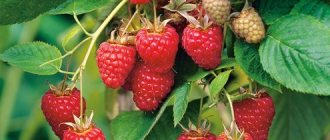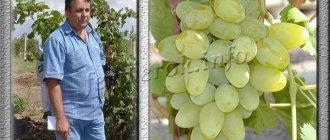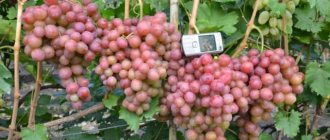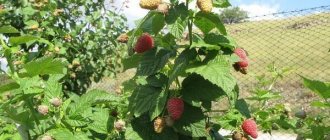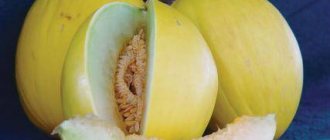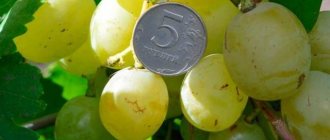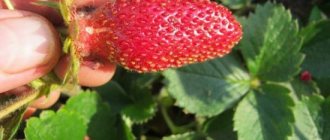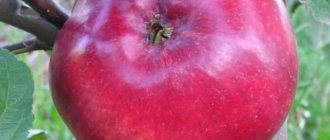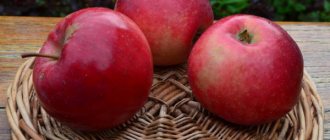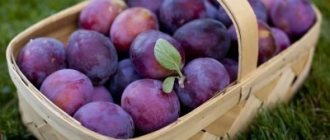Description and features of Himbo Top raspberries
In 2008, Swiss breeders, as a result of successful crossing of the “parental” plants Ottom Blis and Himbo Queen Rafzeter, developed a new crop with exceptional characteristics - the Himbo Top raspberry: the description of the variety indicated such properties as abundant and continuous fruiting, which is why it immediately recommended for cultivation on an industrial scale.
A special feature of this crop, which distinguishes it favorably from other remontant “brothers”, is the rather large fruits: on average about 5-8 g. Sometimes the weight can reach 10 g. The berries do not become smaller throughout the season. The color is bright red, the flesh is soft and juicy, the color does not change after collection. The fruits are tasty, sweet, moderately sour, and very aromatic.
Himbo Top raspberry sizes
Note! Himbo Top raspberries are also recommended to be planted as a honey crop: bees pollinate flowers even in cloudy weather.
Landing
Himbo Top seedlings are usually planted in the fall in order to enjoy delicious berries in the summer. But planting in the spring is also possible, you’ll just have to wait longer for the harvest.
Before planting, you should decide where the bush will grow. It is important to take into account its height and strong shoot formation. You need to choose a well-lit, but not windy piece of land. Before planting raspberries, you must first dig up the area using a spade and remove the weeds. It is better to do this 2 weeks in advance.
Himbo Top is planted in trenches or planting holes. The width, which does not exceed 60 cm, and the depth - 45 cm. There should be a distance of at least 1.5 m between plants, and 3 m between rows.
Then proceed like this:
- The walls of trenches and pits are strengthened so that they do not crumble. A thick plastic film is suitable for this.
- In each planting hole, place 1 layer of soil with a large amount of mineral fertilizers, then another 1 layer without anything, and sprinkle manure mixed with superphosphate on top.
- The planting material is checked, damaged elements of the root system are removed, and the roots themselves are straightened.
- Place the seedlings in prepared holes to a depth of up to the root collar.
- Cover with soil and compact it.
Then it remains to water the planted bush abundantly. With minimal planting requirements, plant survival rate is 98%.
Advantages and disadvantages
The average yield of the variety is up to 4 kg per bush, which is twice as much as the standard Ottom Blis. The berries have high taste, tolerate transportation well, and their shelf life is relatively short. The density of the fruits is average, they are of a regular cone shape. Himbo Top raspberries produce 2 harvests per year: on last year’s shoots (that survived the winter) in June, and on young shoots in August-September.
When planting, it is necessary to take into account the specific conditions of the region. Thus, this variety is not suitable for planting in open ground in the northern regions, where temperatures can drop below -30 °C in winter. In hot regions, the berry bakes and shrivels right on the bush - its appearance deteriorates, the fruit loses its shelf life, and if there is insufficient watering, the raspberries fall off the bush. The situation will be saved by a shading net and one collection in August - September. Summer with prolonged rains takes away the sugar content of the fruits, and obvious sourness appears. It reproduces rather poorly (produces few shoots outside the main root). The shoots have thorns and are prickly, which makes caring for them somewhat difficult.
Agrobiological characteristics
The variety shows powerful growth of annual shoots reaching a height of 1.7−1.9 meters. The number of replacement shoots is small, however, due to the active growth of fruit branches on them, the productivity of raspberry bushes is very high. The laterals of Himbo top begin to form at a distance of 40 cm from the surface of the earth and they grow up to 80 cm in length. To avoid breaking off under the weight of the crop, the side branches must be tied or supported. Violet spikes form on the surface of young shoots, the intensity of which varies depending on the height. Closer to the ground they sit tightly in relation to each other, and as they move towards the top they become rare, up to 5-7 pieces per 5 cm of shoot length. The spines are quite short, which is why they do not interfere with caring for bushes and harvesting. The compound leaves grow strongly wrinkled, consisting of three or five leaf blades, the color of which can vary from turquoise to yellowish-green, depending on the soil and climatic conditions of cultivation. The veins are much lighter than the main pigmentation of the leaves. The shape of the leaves is oval with a pointed end, the average size is 10-12 cm in length and 5-7 in width. The raspberry leaf blade is curved upward and is strongly rugged along the edges.
The flowers of the variety are large, white, located on a peduncle with a slight anthocyanin tint, up to 20 mm in diameter, collected in strongly branching racemes. The petals are 8-9 mm long and are usually oval in shape with a rounded edge. Sepals are sharp, up to 15 mm long, 5 in number. During flowering, the sepals bend strongly forward, and towards the end they bend back. Due to the large size of the flowers, the bushes acquire a very elegant appearance during flowering.
The berries ripen in two periods. At the end of June - beginning of July, fruiting occurs on two-year-old shoots, and in August-September - on annual shoots. When cultivated in light film greenhouses, it is quite possible to continue picking raspberries in the month of October. Surprisingly, Himbo Top alone is capable of creating an entire raspberry conveyor, bearing fruit, with some interval, from mid-summer to late autumn. The berries do not become smaller until the very last harvest. In general, per season you can get up to 3 kg of fruit from a plant, and per hectare of plantings the yield can reach 20 tons. Picking these raspberries is a pleasure - the large berries are easily separated from the stalk, but do not fall off even when left on the bushes.
The appearance of the harvested fruits of this variety is simply magnificent. Shiny, dark red, weighing 6-8 grams, they leave no one indifferent. Their pulp varies in density depending on the time of collection. The fruits of the first harvest, ripened on overwintered shoots, are, as a rule, relatively tender, while the annual growth produces berries that are denser in consistency, nevertheless remaining very juicy and pleasant when chewed. Their taste is very balanced and expressive, quite sweet, with a very subtle, barely noticeable sourness, harmoniously complementing the sensations of food. The aroma is typical for the culture, its intensity is average. The bones are practically invisible. Overall tasting ratings of raspberry fruits are consistently high.
Harvest Himbo Top can be used in many different ways. The variety is excellent for both fresh consumption and processing. It may be of interest to farmers due to its “marketability”, due to the excellent presentation and taste of the berries, as well as amazing yield. Buyers willingly buy this variety, and it usually does not linger on the shelves. In addition, an important point is that the collected berries do not darken for a long time, do not wrinkle, have very good transportability and can be transported over fairly long distances without much loss. As a raw material, our Swiss hero is used in the production of jam, marmalade, marmalade, confiture, confectionery and bakery products. The berries perform well when dried and blast frozen. After thawing, raspberries retain their shape well.
During cultivation, plants show themselves to be very unpretentious and do not require complex care even in the harsh domestic climate. First of all, the ability of Himbo top to grow on all types of soils, both in terms of fertility level and mechanical composition, is noted. Everywhere it demonstrates excellent growth vigor and pleases the owner with excellent productivity. The variety is one of the few that can grow on heavy, dense soils with low water and air permeability. The second positive point is its increased resistance to fungal and bacterial diseases, as well as pests. Due to this, this variety of raspberry in the West is often used in organic farming, in which plantations are minimally treated with plant protection products. The experience of domestic amateur gardeners also confirms the possibility of obtaining an environmentally friendly harvest. But the winter hardiness of the “Swiss” is not outstanding, and therefore its cultivation in frost-prone regions is possible only with a guaranteed high snow cover. In summer it can withstand short-term droughts, but for consistently high productivity it is also necessary to have sufficient soil moisture.
Subtleties of care
Thanks to simple care, the crop takes root well in the garden. Because of its ease and ease of maintenance, Himbo Top raspberries are gradually displacing other varieties from Russian dachas and farmsteads.
Watering and fertilizing
Even beginners can cope with growing this crop. First of all, it needs to maintain the moisture content of the top layer of soil at a high level, since it does not tolerate drought. In spring and early summer, it needs abundant regular watering, at least 2 buckets of water per bush per week.
The water supply during fruiting can be reduced to 1 bucket per bush per week in dry weather or stopped altogether if it is humid outside. You should always water in the evening so that the moisture penetrates to the maximum depth overnight and reaches the roots.
Ammonium nitrate
Due to the growth of weeds, the plant is suppressed and deprived of nutrition, since it has a superficial root system. Mulching the soil under the shoots is of great help. It prevents moisture evaporation, prevents the growth of weeds, and also helps plantings to overwinter, covering the roots from frost. The height of the mulch should be at least 8-10 cm; sawdust, peat, hay, straw, and weeded weeds are suitable for this.
Agrotechnical features
Despite its foreign origin, Himbo top does not require any special specifics in the growing process. In this regard, it is cultivated according to the usual schemes for remontants, taking into account the existing advantages and disadvantages in the agrobiology of the variety.
Gentle slopes are ideal for planting, the exposure of which is chosen depending on the climate. In the hot south, slopes of predominantly cool directions are used, and in the north - warm ones. Flat areas are also quite suitable for raspberries, but it is better if they are protected from the winds by the features of the relief, since snow is often blown away from the open plains in winter, as a result of which our not very frost-resistant hero risks death. As has already been said, any soil is suitable, except for overly acidic, saline, damp, and especially waterlogged ones.
Due to the high growth activity of bushes of this variety, they need to be provided with sufficient space to facilitate their care and eliminate unnecessary competition between plants for moisture, nutrients and sunlight. It is recommended to leave 2.5-3 meters between rows, and 50-70 cm between bushes in a row. Planting is carried out in spring or autumn, the main thing is that the plant is in the dormant phase at this time. It is mandatory to equip a trellis on the site for tying up shoots and fruit branches that bear a bountiful harvest. They try to water vegetating raspberries as needed, periodically combining this procedure with fertilizing with mineral fertilizers. The soil under the Himbo top bushes is regularly weeded, and the two-year-old shoots that bear fruit are promptly removed. In frost-prone areas, annual shoots are bent to the ground in the fall so that they are covered with snow, or they are completely cut out, transferring the bushes only to late summer fruiting.
Harvesting is carried out in the morning, after the dew has dried, or in the evening. You should not use hot daytime for this, since the berries of such a harvest will have poorer keeping quality and transportability. It is not recommended to put collected raspberries in bulk containers, because... Despite its sufficient density, the berry in this case may become wrinkled.
Raspberry harvest Himbo Top
Raspberries are a fast-growing crop and can produce a harvest already in the second year after planting. Thanks to the long fruiting period and the wonderful appearance of the berries, the Himbo Top variety is ideal for growing products for sale. Fruit ripening begins in early August and lasts until October. By growing this plant in a greenhouse, under cover, the harvest can be harvested until the beginning of November.
Large and tasty Himbo Top raspberries
Those who are just starting their gardening “career” should start by planting Himbo Top raspberries. Regular but easy care will allow you to collect sweet and juicy fruits quickly enough, which will not disappoint the beginner and will inspire you to other gardening feats.
Variety care
Remontant raspberry varieties require care. Plants require frequent watering, fertilizing and timely pruning of remontant raspberries in autumn and spring. In cold climates, bushes are mulched with dry leaves and covered with agrofibre to prevent raspberries from freezing.
Watering
In the absence of precipitation, Himbo Top raspberries are watered every week with warm water. The soil under the plants should be wet to a depth of 30 cm. After adding moisture, loosen the soil and remove weeds.
Watering is especially important during flowering and berry formation. When there is a lack of moisture in plants, the ovaries fall off and the yield decreases.
Advice! For extensive plantings of raspberries, drip irrigation is installed to ensure an even supply of moisture.
Excess moisture is also detrimental to raspberries. The root system of plants does not receive access to oxygen, which impairs the absorption of nutrients. With high humidity, there is a high risk of developing fungal diseases.
In the fall, the last pre-winter watering of raspberries is carried out. The presence of moisture will allow the plants to prepare for winter.
Feeding
Raspberry Himbo Top reacts positively to fertilization. When grown in fertile areas, raspberries are fed from the third year after planting.
Both mineral fertilizers and the use of organic matter are suitable for the variety. It is better to alternate treatments with an interval of 2-3 weeks.
In the spring, nitrogen fertilizers are applied to allow plants to increase their green mass. The use of nitrogen should be abandoned during flowering and fruit ripening.
Methods for spring feeding Himbo Top raspberries:
- fermented mullein infusion 1:15;
- nettle infusion diluted with water 1:10;
- ammonium nitrate in the amount of 20 g per 1 sq. m.
In summer, raspberries are fed with substances containing potassium and phosphorus. For 10 liters of water, 30 g of superphosphate and potassium sulfate are required. The solution is watered at the roots of the plants.
Folk remedies for raspberries include dolomite flour or wood ash. Fertilizers are incorporated into the soil during loosening.
Tying up
According to the variety description and photo, Himbo Top raspberries grow up to 2 m. Under the weight of the berries, the shoots bend towards the ground. Plants are tied to a trellis or separate supports.
Along the edges of the site, posts are driven in, between which wire or rope is pulled at a height of 60 and 120 cm from the ground. The branches are arranged in a fan-shaped manner. If necessary, the number of plant supports is increased.
Trimming
In autumn, it is recommended to prune remontant raspberries at the root. Branches 20-25 cm long are left above the surface of the ground. Next year new shoots will appear that will bring a harvest.
If you do not prune raspberries, then in the spring you need to remove frozen and dry branches. If part of the plant is frozen, the shoots are shortened to healthy buds.
Important! Remontant raspberries are not pinched. The procedure slows down the development of shoots and reduces yield.
In summer, excess growth is removed from the Himbo Top variety. For each raspberry bush, 5-7 shoots are enough. The shoots can be used for propagation. To do this, it is separated from the original bush and rooted in the garden bed. After the root system is formed, the plants are transferred to a permanent location.
Diseases and pests
Himbo Top raspberries are resistant to fungal diseases that affect the root system. The development of diseases occurs under high humidity, lack of care, and high planting density.
Fungal diseases appear as brown spots on the stems and leaves of raspberries. If symptoms are present, plants are sprayed with Bordeaux mixture, solutions of Topaz, Fitosporin, Oxyx.
Attention! Disease carriers are often insects, which also cause direct damage to plantings.
The most dangerous pests for raspberries are spider mites, aphids, beetles, caterpillars, leafhoppers, and gall midges. Before flowering, plants are treated with Iskra, Karate, and Karbofos.
During the ripening period, it is better to avoid chemicals. They are replaced with folk remedies: infusions of onion peels, garlic, tobacco dust.
Reviews from gardeners
The opinions of those who grow or are just planning to acquire raspberries from Himbo Top vary. Many people note the high yield and large, tasty berries. But at the same time they do not like poor frost resistance. Others emphasize that the shrub does not require special care, but at the same time they do not like the tall growth and spreading nature of the plant.
Mikhail, Kursk: “The only thing I didn’t like about Himbo Top was the thorns, it’s impossible to fit! A couple of shoots broke under the weight of the berries, I didn’t have time to tie them up, now I’ll be smarter.”
Elena, St. Petersburg: “I love remontant varieties, that’s why I forked out for Himbo Top. The price, of course, is steep, but in one summer it is compensated by the number of berries!”
Valentina, Krasnodar: “I thought that I would give Himbo Top to neighbors or sell it later. The berries are tasty, and the yield is high. And here - as if it were not so, it does not want to reproduce in any way. But I’m not offended, I have raspberries.”
5 / 5 ( 1 voice )
Diseases and pests
There are many diseases and pests of raspberries.
The Himbo Top variety is resistant to many infectious and fungal diseases:
- root rot;
- late blight;
- mosaic;
- purple spot;
- powdery mildew.
Some exceptions are root canker and Fusarium wilt. To minimize losses from all these misfortunes, you need to regularly inspect the bushes for diseases and the presence of pests, which are often the distributors of diseases.
Modern insecticides can effectively control insects. In the event of a threat of fungal diseases, it is necessary to carry out preventive treatment of plantings with Bordeaux mixture and phytosporin.
Treatment with chemicals should be stopped 3 weeks before picking berries.
Methods for growing and caring for Himbo Top
For this crop, agrotechnical measures must be strictly observed.
- How to water
There is no special requirement. As soon as the soil dries out, then water it. to a depth of 50 cm. You can dig trenches around the plants and water them. Then there will be no water spreading. And the crop will receive enough moisture.
Important!
Don’t forget to add mulch from sawdust, straw or pine needles after watering.
- Trimming
In cold regions, pruning is done in the fall, cutting right to the roots. Then they arrange mulch.
If the cultivation is in two-year cycles, without complete pruning, then such work is carried out in the spring. Remove the affected shoots.
You can also remove non-woody, green growth in the fall. Just cut at the roots to avoid rotting and infections.
Branches may break during fruiting; prune them before autumn. The pruning areas must be treated with ash.
- How to feed
Plants need feeding. When they overwinter after you planted them last year, give them nitrogen fertilizer to stimulate growth. Such fertilizing will produce new fruit branches in large quantities.
Important!
Nitrogen fertilizer should not be used at a time when fruits are forming. Otherwise there will be a lot of leaves and the ovary will be lost.
When you loosen the soil of the raspberry trees, usually at the end of May, add organic matter with water. From chicken droppings - 1/20 or cow manure - 1/10.
To strengthen plants and increase their resilience during the winter cold, give them a potassium-phosphorus composition in the fall.
Over the course of a year, feed the plants in 3 approaches. If fruiting is abundant, after all the harvests have been harvested, feed the berry gardens with solutions containing bird droppings (chicken). They will do well in winter.
Preparing for winter
Since Himbo Top does not tolerate cold well, it is worth taking care of shelter for winter. You need to do this:
- Thin out the bushes if necessary and remove damaged shoots.
- Immediately after the last watering in late September - early October, the bushes are pruned to 25 cm. In the southern regions, where winters are not so severe, you can simply press the shoots to the ground.
- Cover the cut or pressed branches with film in 2 rows. Additionally, you can cover it with agrofibre or spruce branches.
- Press the insulation layer.
In spring, the shelter is removed and the soil is loosened.
Trimming
In the warm season, the crop does not need pruning. However, some elements of the plant will have to be removed in the following cases:
- before wintering for the entire length;
- with the onset of spring, in case of freezing of shoots;
- in the fall, if there are traces of disease on the branches.
In other cases, pruning will lead to the fact that all the plant’s energy will be spent on regenerating the removed area. The cutting area is treated with wood ash.
Mulching
Himbo Top responds well to regular loosening and mulching. Mulching is carried out in the spring, immediately after weeding.
To prevent drying out of the soil on which the crop grows, use:
- straw;
- sawdust;
- pine needles and tree bark.
It is advised to mulch the raspberry tree with peat or compost, so after winter it will all turn into fertilizer. The layer thickness is usually 6-10 cm. In addition to the fact that mulching prevents moisture from evaporating, it additionally reduces the growth of weeds.
